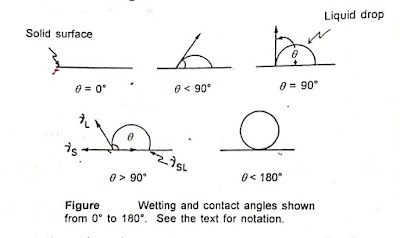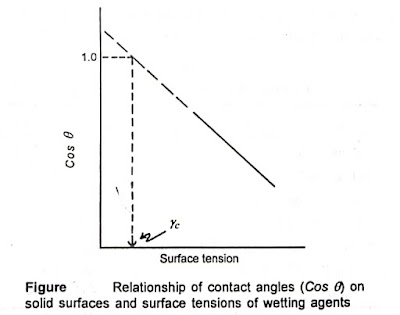Important Question on Solubilization for BPharmacy 4th Semester
- Define Wetting. What are its applications?
- How surfactants are capable of wetting of powder.
- Define contact angle. Write its various values ranging from 0° to 180°.
- Define critical surface tension. Give its application.
- Define solubilization.
- Explain process of micelles solubilization with labelled diagram.
Contents
1. Define Wetting. What are its applications?
Wetting Phenomena In industry, large quantities of powders such as talc or charcoal are added to water. These powders do not get wetted properly in spite of their higher densities than water, instead these float on the surface.
Wetting is an adsorption process in which an intimate contact of the solids with liquid phase is achieved.
This process is important in many ways in pharmacy.
(i) Intimate contact of solids or liquids with liquids is an initial step towards the preparation of suspensions and emulsions.
(ii) In case of granulation prior to tableting the powders are mixed with a liquid binding agents. The success of this process in part depends on the wetting and spreading of the liquid over the solid
(iii) Film coating requires the wetting and spreading of liquids (con tining coating material) over the tablet surface.
(iv) Dissolution of a tablet or a capsule necessitates the penetration of liquid into pores of the dosage form.
2. How surfactants are capable of wetting of powder.
Surfactants are used to aid wetting of powders, because they are capable of
- Lowering the interfacial tension
- lowering the of contact angle between the solids and liquids.
- displacing air and permit the intimate contact.
3.Define contact angle. Write its various values ranging from 0° to 180°.
Contact angle is used as an indicator to evaluate the efficiency of a wetting agent.
Contact angle can be defined as an angle between the liquid droplet and surface over which it spreads.
The contact angles can take up any value between 0 and 180°. Contact angle can be conveniently estimated by placing a drop of liquid on a solid surface.
4.Define critical surface tension. Give its application.
Critical Surface Tension The relationship between the advancing contact angle and the surface tension of the wetting liquid for many solid surfaces has been established. A linear relationship between Cos θ and surface tension has been obtained.
The surface tension obtained to Cos θ = 1 is known as the critical surface tension, λc of the solid. The λc value is a characteristic property of a solid and may be related to the composition of the solid.
Applications:
- Critical surface tension values of polymers find applications in coating the tablets and granules.
- These values have been studied, for different tablets of acetyl salicylic acid, in order to ascertain the effect of adjuvants on the wettability of tablet surfaces by polymer film coatings.
5.Define solubilization.
The property of surface active agents to cause an increase in the solubility of organic compounds in aqueous systems is called solubilization. This property is exhibited at or above CMC only which indicates that micelles are involved in the phenomenon. Nonpolar materials such as aliphatic hydro carbons get dissolved in the non-polar core of the micelle while polar materials such as sugar and glycerol get adsorbed at the micellar surface (i.e. at the micelle/water interface). Amphipathic materials such as octanol and phenols are believed to become oriented in the palisade layer in a manner similar to that of the surface active agent, i.e., with their polar orom polar groups oriented towards the aqueous phase and the lipophilic groups inside the micelles. Solubilization amphiphilic compounds by nonionic surfactants generally takes place by their orientation or inclusion between the long hydrophilic polyoxyethylene chains.
6.Explain process of micellar solubilization with labelled diagram.
Applications-micellar solubilisation : Poorly water-soluble drugs are normally solubilised in aqueous solutions by employing association colloids. Surface active agents at and above cmc form micelles in aqueous dispersions. These micelles are spherical in shape and contain a hydrophobic interior and a hydrophilic surface. Hydrophobic pockets inside micelles offer an environment for solubilisation of poorly water soluble drugs. This phenomenon is called as micellar solubilisation. Examples are solubilised systems containing volatile oils (peppermint oil), coal tar materials, phenobarbital, sulfonamides and vitamins. The hydrolytic or oxidative decomposition of drugs are reduced prevented by using solubilised products.
The micelles are formed by non ionic surface active agent such as Tween 80. The following observations are made regarding the micellar solubilisation of drugs.
1. Benzene and toluene are nonpolar molecules. So these are solubilised in the hydrocarbon interior (core) of micelles.
2. Salicylic acid is slightly polar molecule. The nonpolar portion (benzene ring) is directed towards the central region of the micelles. The polar group (hydroxyl group) tends to align and accommodate itself on the surface outside), i.e., hydrophilic (aqueous) environment.
3. p-Hydroxybenzoic acid is a highly polar molecule. This is aligned itself between the hydrophilic chains on the surface the micelles.



